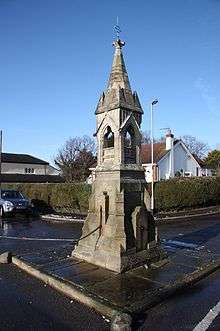Legbourne, Lincolnshire
| Legbourne | |
 All Saints Church, Legbourne |
|
 Legbourne |
|
| Population | 644 (2011 Census)[1] |
|---|---|
| OS grid reference | TF368843 |
| – London | 130 mi (210 km) S |
| Civil parish | Legbourne |
| District | East Lindsey |
| Shire county | Lincolnshire |
| Region | East Midlands |
| Country | England |
| Sovereign state | United Kingdom |
| Post town | Louth |
| Postcode district | LN11 |
| Dialling code | 01757 |
| Police | Lincolnshire |
| Fire | Lincolnshire |
| Ambulance | East Midlands |
| EU Parliament | East Midlands |
| UK Parliament | Louth and Horncastle |
|
|
Coordinates: 53°20′19″N 0°03′13″E / 53.338573°N 0.053557°E
Legbourne is a village and civil parish in the East Lindsey district of Lincolnshire, England. It is situated approximately 3 miles (5 km) south-east from the town of Louth.
The Greenwich Prime Zero meridian line passes through the village.
History
The Priory of Legbourne was founded by Robert Fitz Gilbert of Tathwell about 1150, apparently to receive Cistercian nuns, known as "The Nuns of Keddington" (sometimes Haddington).[2] The Priory was officially dissolved in 1536, although it seems it was still occupied by a number of nuns at the time of the Lincolnshire Rising when the nuns were dragged out by the excited mob.[2] The original endowment of the Priory consisted of lands belonging to Robert Fitz Gilberts fee in Tathwell, Legbourne, Hallington, and the churches of Farlesthorpe, Saltfleetby St Peter, Raithby, Hallington, Somercotes, Conisholme, and half that of Legbourne.[2] The site of the priory is in the grounds of Legbourne Abbey, at present a private house, the only visible remains of the original building being earth mounds.[3]
Governance
An electoral ward in the same name exists. This ward stretches north west to Elkington with a total population taken at the 2011 census of 1,891.[4]
Landmarks
Legbourne church was built about 1380, and is dedicated to All Saints.[5] It was extensively rebuilt in 1865, and is a Grade I listed building.[6] The church clock was presented to the village by Thomas Cheney Garfitt in 1890.[3]

The village pump, Grade II listed,[7] is a canopied and pinnacled stone structure standing in front of the church, built by Canon J. Overton in 1877 in memory of his mother. It was the principal supply of water to the village until 1953, when mains water was introduced to the village.[3]
Legbourne tower mill, which is Grade II Listed,[8] was built by Thomas Davy in 1847 after an older post mill burned down. It is now a private dwelling.[3]
Legbourne Road railway station, now disused, was established in 1863[3] by the Great Northern Railway.[9] Whilst the level crossing has disappeared the old Station House exists as a private residence.[3]
Legbourne Wood is one of the few remaining ancient woodlands in eastern Lincolnshire and the largest of the Lincolnshire Wildlife Trust woodland nature reserves. The Trust bought the wood in 2004. The canopy at Legbourne is ash and oak. Beneath the trees, over 60 species of wildflowers have been recorded including primrose, early purple orchid, bluebell, wood anemone, sweet woodruff, wood sorrel and lesser celandine. There is a varied bird population, including one of the largest heronries in the county.[10]
Amenities

Legbourne and Little Cawthorpe Community Centre was built in 1990 as a sports and functions hall, and includes playing fields used for both sports and car boot sales.[11] The village retains a post office and general store.[3] The local public house, the Queens Head Inn, was closed in January 2012.[12] Since 1982 there has been a trout farm at the village. There is a day nursery and out of school club.[13]
East Wold Primary School, built in 1993, serves Legbourne and surrounding villages.[14]
Population
| Population of Legbourne Civil Parish | ||||||||||||||||
|---|---|---|---|---|---|---|---|---|---|---|---|---|---|---|---|---|
| Year | 1801 | 1811 | 1821 | 1831 | 1841 | 1851 | 1881 | 1891 | 1901 | 1911 | 1921 | 1931 | 1951 | 1961 | 2001 | 2011 |
| Population[15] | 280 | 308 | 412 | 449 | 461 | 551 | 476 | 464 | 369 | 357 | 334 | 416 | 389 | 347 | 627 | 644 |
 |
Louth, Elkington, Market Rasen | Stewton, North Cockerington, Alvingham | Little Carlton, Theddlethorpe, Saltfleetby |  |
| Raithby cum Maltby, Withcall, Hainton | |
Great Carlton, Gayton le Marsh, Mablethorpe | ||
| ||||
| | ||||
| Little Cawthorpe, Haugham Horncastle | Muckton, Burwell, Spilsby | North Reston, Castle Carlton, Sutton on Sea |
References
- ↑ "Parish population 2011". Retrieved 20 August 2015.
- 1 2 3 "Victoria County History". Houses of Cistercian Nuns-Priory of Legbourne. British History. Retrieved 19 May 2011.
- 1 2 3 4 5 6 7 "Legbourne"; Louthuk.com. Retrieved 19 May 2012
- ↑ "Ward population 2011". Retrieved 20 August 2015.
- ↑ "Legbourne All Saints Church"; Lincolnshire.gov.uk. Retrieved 19 May 2011
- ↑ "Church of All Saints, Legbourne"; Britishlistedbuildings.co.uk. Retrieved 19 May 2011
- ↑ "Pump, Legbourne"; Britishlistedbuildings.co.uk. Retrieved 19 May 2012
- ↑ "Tower Mill, Legbourne"; Britishlistedbuildings.co.uk. Retrieved 19 May 2011
- ↑ "Legbourne Disused Station". Disused Stations Website. Retrieved 19 May 2011.
- ↑ "Legbourne Wood", Lincstrust.org.uk. Retrieved 19 May 2011
- ↑ "Legbourne & Little Cawthorpe Community Centre"; Lincolnshire.gov.uk. Retrieved 19 May 2011
- ↑ "Lost pubs in Legbourne"; Closedpubs.co.uk. Retrieved 23 April 2012.
- ↑ "Red Hen Children's Day Nursery and Kids Crew Out of School Club"; Lincolnshire.gov.uk. Retrieved 19 May 2011
- ↑ "East Wold Church of England Primary School"; Lincolnshire.gov.uk. Retrieved 19 May 2011
- ↑ "Legbourne CP/AP"; Visionofbritain.org.uk. Retrieved 25 August 2011
External links
 Media related to Legbourne, Lincolnshire at Wikimedia Commons
Media related to Legbourne, Lincolnshire at Wikimedia Commons